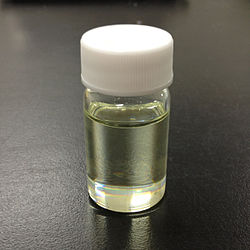Titanium(IV) chloride
 |
|
 |
|
| Names | |
|---|---|
|
IUPAC name
Titanium tetrachloride
|
|
|
Systematic IUPAC name
Tetrachlorotitanium
|
|
| Other names
Titanium(IV) chloride
|
|
| Identifiers | |
|
3D model (Jmol)
|
|
| ChemSpider | |
| ECHA InfoCard | 100.028.584 |
| EC Number | 231-441-9 |
| MeSH | Titanium+tetrachloride |
|
PubChem CID
|
|
| RTECS number | XR1925000 |
| UN number | 1838 |
|
|
|
|
| Properties | |
| TiCl 4 |
|
| Molar mass | 189.679 g/mol |
| Appearance | Colourless liquid |
| Odor | penetrating acid odor |
| Density | 1.726 g/cm3 |
| Melting point | −24.1 °C (−11.4 °F; 249.1 K) |
| Boiling point | 136.4 °C (277.5 °F; 409.5 K) |
| Reacts | |
| Solubility | soluble in ethanol, HCl |
| Vapor pressure | 1.3 kPa (20 °C) |
| −54.0·10−6 cm3/mol | |
|
Refractive index (nD)
|
1.61 (10.5 °C) |
| Viscosity | 827 μPa s |
| Structure | |
| Tetragonal | |
| Tetrahedral | |
| 0 D | |
| Thermochemistry | |
|
Std molar
entropy (S |
355 J·mol−1·K−1 |
|
Std enthalpy of
formation (ΔfH |
−763 kJ·mol−1 |
| Hazards | |
| Safety data sheet | MSDS |
|
EU classification (DSD)
|
|
| R-phrases | R14, R34 |
| S-phrases | (S1/2), S7/8, S26, S30, S36/37/39, S45 |
| NFPA 704 | |
| Related compounds | |
|
Related titanium chlorides
|
Titanium(II) chloride |
|
Related compounds
|
Hafnium(IV) chloride Titanium(IV) bromide |
|
Except where otherwise noted, data are given for materials in their standard state (at 25 °C [77 °F], 100 kPa).
|
|
|
|
|
| Infobox references | |
Titanium(IV) bromide
Titanium(IV) fluoride
Titanium(IV) iodide
Zirconium(IV) chloride
Titanium tetrachloride is the inorganic compound with the formula TiCl4. It is an important intermediate in the production of titanium metal and the pigment titanium dioxide. TiCl4 is an unusual example of a metal halide that is highly volatile. Upon contact with humid air, it forms spectacular opaque clouds of titanium dioxide (TiO2) and hydrogen chloride (HCl). It is sometimes referred to as "tickle" due to the phonetic resemblance of its molecular formula (TiCl4) to the word.
TiCl4 is a dense, colourless distillable liquid, although crude samples may be yellow or even red-brown. It is one of the rare transition metal halides that is a liquid at room temperature, VCl4 being another example. This property reflects the fact that TiCl4 is molecular; that is, each TiCl4 molecule is relatively weakly associated with its neighbours. Most metal chlorides are polymers, wherein the chloride atoms bridge between the metals. The attraction between the individual TiCl4 molecules is weak, primarily van der Waals forces, and these weak interactions result in low melting and boiling points, similar to those of CCl4.
...
Wikipedia

